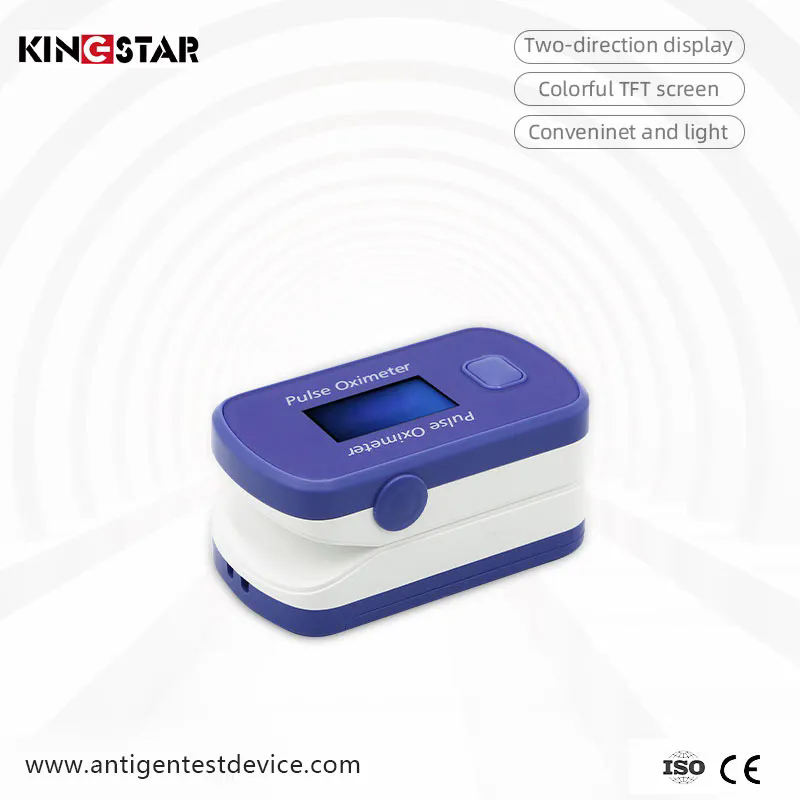Detailed Overview of Pulse Oximeter Handheld Digital Fingertip Pulse Oximeter
2024-07-30
A handheld digital fingertip pulse oximeter is a medical device used to measure the oxygen saturation level (SpO2) in the blood and heart rate. It’s a non-invasive and convenient tool commonly used in healthcare settings and for personal health monitoring. Here’s a comprehensive overview:
Key Features
1. Measurement Capabilities:
- Oxygen Saturation (SpO2): Measures the percentage of oxygen in the blood, indicating how well oxygen is being transported to the body’s tissues.
- Pulse Rate: Measures the heart rate in beats per minute (bpm).
2. Display:
- Digital Screen: Typically features an LCD or LED screen that displays SpO2 levels, pulse rate, and sometimes additional information like pulse strength.
- User Interface: Includes clear and easy-to-read digits, often with backlighting for visibility in various lighting conditions.
3. Design:
- Fingertip Placement: Designed to clip onto a fingertip for quick and accurate measurements. The device usually has a spring-loaded clip to accommodate different finger sizes.
- Compact and Portable: Lightweight and compact, making it easy to carry and use in various settings, from home to healthcare facilities.
4. Functionality:
- Real-Time Monitoring: Provides real-time readings of oxygen saturation and heart rate.
- Automatic Shutoff: Includes an automatic shutoff feature to conserve battery life when not in use.
5. Power Supply:
- Battery Operated: Typically powered by AAA batteries or rechargeable batteries, depending on the model.
6. Additional Features (may vary by model):
- Pulse Beep: Some models emit an audible beep with each pulse to aid in monitoring.
- Perfusion Index: Measures the strength of the pulse signal, which can be useful for assessing the reliability of the SpO2 reading.
- Data Logging: Some advanced models may have the capability to store and track historical data.
Benefits
1. Convenience:
- Easy to Use: Simple to operate with one-button functionality or minimal controls.
- Non-Invasive: Provides a quick and painless way to monitor oxygen levels and heart rate.
2. Health Monitoring:
- Early Detection: Helps in detecting low oxygen levels or abnormal heart rates, which can be crucial for individuals with respiratory or cardiovascular conditions.
- Routine Checks: Useful for regular health checks, especially for individuals with chronic health issues or those undergoing treatment.
3. Portability:
- Compact Design: Easily portable and suitable for use at home, at work, or while traveling.
4. Accuracy:
- Reliable Readings: Provides accurate and reliable readings when used correctly, ensuring effective monitoring of vital signs.
Considerations
1. Accuracy and Calibration:
- Proper Usage: Ensure the device is used according to the manufacturer’s instructions for accurate readings. Factors such as nail polish, poor circulation, or movement can affect accuracy.
- Regular Calibration: Some devices may require periodic calibration or maintenance to ensure accurate readings.
2. Battery Life:
- Battery Replacement: Regularly check and replace batteries as needed to ensure the device remains operational.
3. Range of Use:
- Health Conditions: While useful for general monitoring, the pulse oximeter is not a substitute for professional medical evaluation and should not be used to diagnose or treat medical conditions.
4. Environmental Factors:
- External Interference: Be aware that extreme temperatures, high altitudes, or other environmental factors can affect the device’s performance.
A handheld digital fingertip pulse oximeter is a valuable tool for monitoring oxygen saturation and heart rate, offering convenience and portability for both personal and clinical use. Proper use and maintenance will help ensure accurate readings and effective health monitoring.



